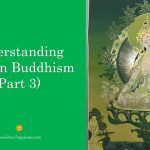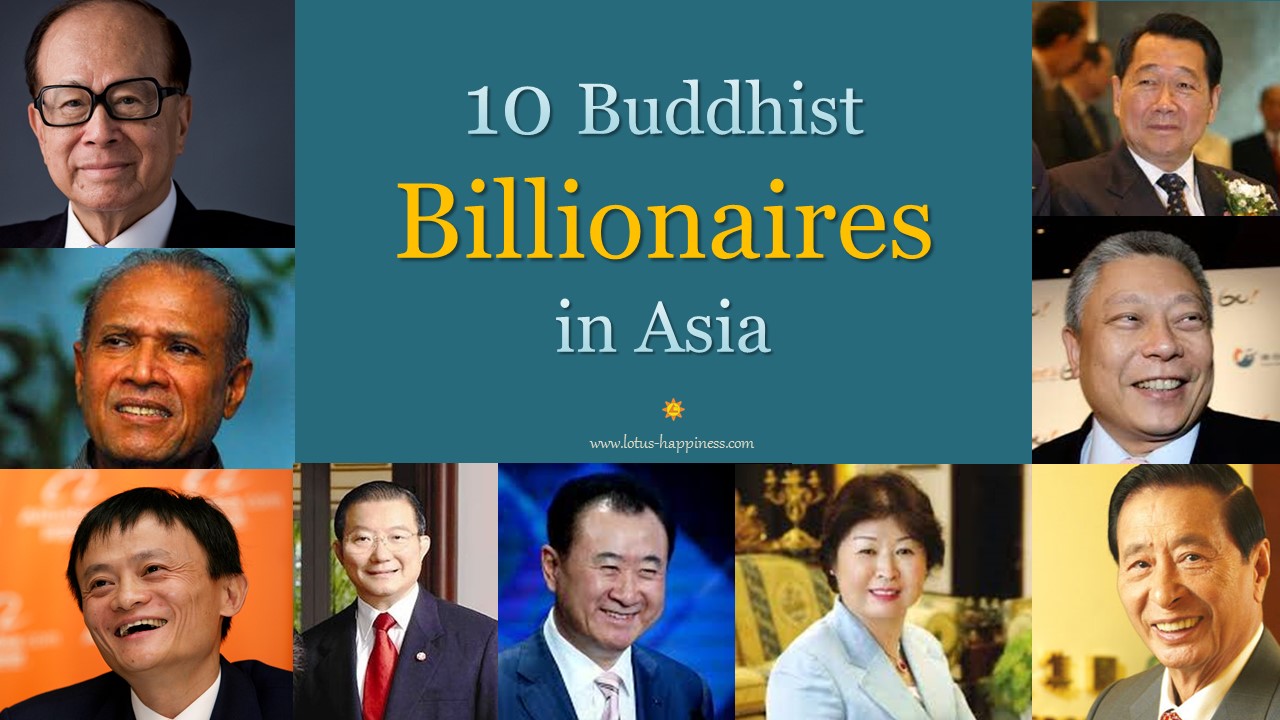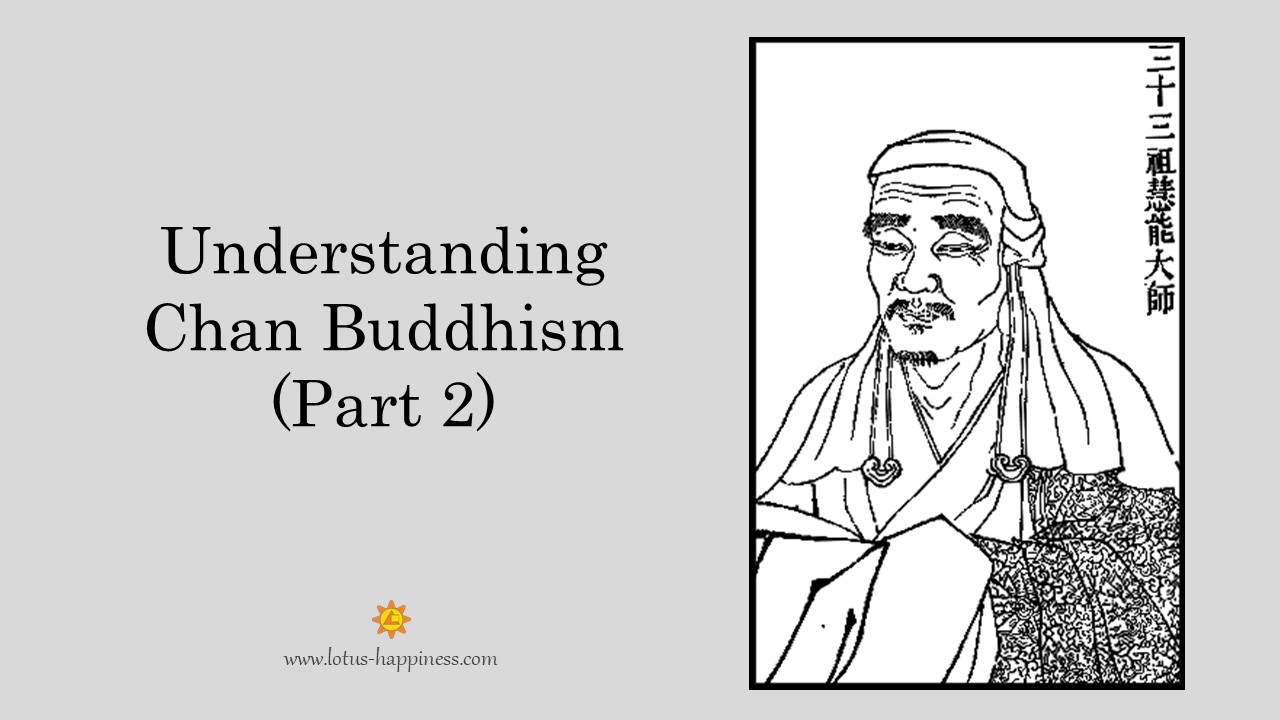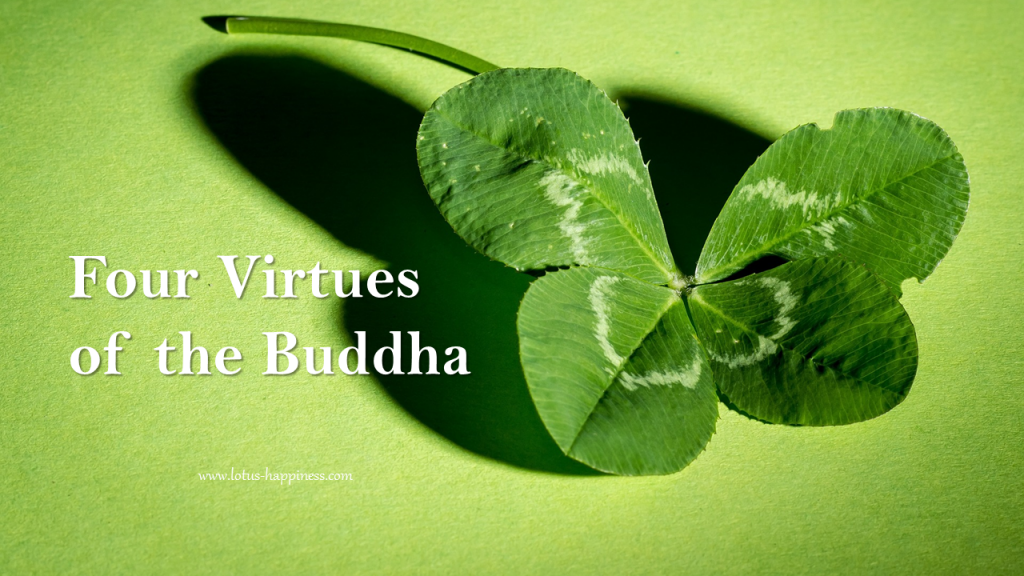
Four Virtues of the Buddha
The Buddha embodies the four virtues, namely True Self, Eternity, Purity and Happiness, as expounded in Mahaparinirvana Sutra. These noble qualities are the true nature of Buddha’s life. Ordinary people like us can also embrace these qualities if we choose to embrace the Lotus Sutra of the One Buddha-Vehicle and live our lives to the fullest.
The four virtues of True Self, Eternity, Purity, and Happiness are in direct opposite to No Self (anattaa), Impermanence (anicca), Emptiness (Sunyata), and Suffering (dukkha) as taught by the Buddha in the early Buddhism. As you can see, these four provisional teachings are relevant in the context of a human world. They are the “truths” in the conditioned world. However, they are completely refuted by the Buddha himself in Mahaparinirvana Sutra.
In the human world, strife and suffering are abound. Nothing is permanent. To survive and thrive in the long term, we constantly strive to change and reinvent ourselves.
Nonetheless, the Buddha is always mindful of his purpose on Earth – to impart the Law of Anuttara Samyak Sambodhi to his disciples so as to lead them to the shore of Buddhahood. The Buddha never stops even a moment to inculcate the aspiration of Buddhahood in us.
In Chapter 15: Emerging of the Earth in the Lotus Sutra, four bodhisattva leaders emerged from the Earth: Superior Actions, Boundless Actions, Pure Actions, and Steadfast Actions. According to Tian Tai’s and Nichiren’s interpretation, these bodhisattvas represent the four virtues:
True Self: Bodhisattva Superior Actions
Eternity: Bodhisattva Boundless Actions
Purity: Bodhisattva Pure Actions
Happiness: Bodhisattva Steadfast Actions
Meanwhile, the four groups, through the divine powers of the Buddha, saw the bodhisattvas filling the empty space of immeasurable hundreds of thousands of millions of billions of lands. Among these bodhisattvas, there were four leaders. The first leader was called Superior Actions, the second leader was called Boundless Actions, the third leader was called Pure Actions, and the fourth leader was called Steadfast Actions. These four bodhisattvas were the foremost teachers and leaders among the assembly. (LS 15: 1.8)
Nichiren claims that he is the Bodhisattva Superior Actions, which represents True Self. There is some truth in it because Nichiren did live a life true to his nature and personality.
True Self
“Who am I?”
“Why am I here on Earth?”
These perplexing existential questions can be tackled by the teaching of True Self.
The purpose of life is to discover who we are and live the life true to who we are. Not everyone has the privilege to live a life to his or her fullest potential. It takes tremendous courage, boundless grit, and inexorable resilience in order to achieve this goal.
To understand True Self, we need to look at two perspectives: spiritual and secular.
True Self is the Buddha-Nature
From the spiritual perspective, the universal True Self that transcends all boundaries of race and religion is that of the Buddha-Nature. The Buddha-Nature is the state of potentiality. It means we have the potential to attain Buddhahood. However, if we are not aware of the One Buddha-Vehicle, or the Law of Supreme Perfect Enlightenment (the seed of Buddhahood) as taught in the Lotus Sutra, then the journey to Buddhahood remains remotely long.
The Buddha-Nature resembles a fertile land, waiting for the seed of Buddhahood to be sowed. How can we spread the seed of Buddhahood widely? Here are the two methods:
- Having an awareness of the One Buddha-Vehicle by reading the Lotus Sutra or learning about its meaning in books or blogs (self-study)
- Through associating with people who are diligently practising the Lotus Sutra (friendship)
True Self is the Natural Strength
From the secular perspective, True Self is the strength, aptitude, or talent of an individual. All of us are born with a unique gift. This talent is something that comes naturally to us. Our strength is our nature, our gifted attribute.
A Buddha is a person who is living true to himself. Do not think that a Buddha is just a “plain vanilla” with no distinctive characteristics. Every Buddha in the Universe has his own unique “personality”. We can get a glimpse of this unique personality of a Buddha through his title when he attains Buddhahood. Here are some examples:
Shakyamuni Buddha:
The name Śākya is derived from the Sanskrit word śakya, which means “the one who is capable”. The name of his Buddha-land is called Saha, which means “endurance”.
The strengths of Shakyamuni Buddha are Diligence and Endurance. These traits are demonstrated in the Lotus Sutra:
Evidence of Diligence (Chapter 9):
Meanwhile, the Bhagavat, having perceived the thoughts of these bodhisattvas, responded: “O virtuous men! When Ananda and I were at the place of King of Emptiness Buddha, both of us conceived the aspiration to attain Supreme Perfect Enlightenment. Ananda was always delighted in the wide knowledge of the Law while I constantly advanced the practice diligently. Therefore, I have already attained Supreme Perfect Enlightenment while Ananda protects and upholds my Law. Similarly, he will protect the Treasury of the Law of many Buddhas in the future, teaching, transforming, and leading multitudes of bodhisattvas. Such was his original vow and hence this is his prophecy.” (Lotus Sutra 9: 2.2)
Evidence of Endurance (Chapter 20: Bodhisattva Never Disrespectful):
“For many years, he continued as such and was always being upbraided. He never, however, let anger get the better of him. Whenever he uttered the same phrase, ‘You will surely become Buddhas!’ some people would take sticks of wood, tiles, or stones to pelt at him. To escape the beating, he would run away but he continued shouting at the top of his voice: ‘I will never treat you with disrespect for all of you will surely become Buddhas!’ By virtue of him repeating the same phrase, arrogant monks, nuns, lay male disciples, and lay female disciples called him Never Disrespectful. (Lotus Sutra 20: 1.10)
“O Gainer of Great Authority! Who do you think this Bodhisattva Never Disrespectful was at that time? This person is none other than I myself! In my previous lifetime, had I not accepted, embraced, read, recited, and expounded the Lotus Sutra for others, I would never have been able to attain Supreme Perfect Enlightenment so quickly. Because I was able to accept, embrace, read, recite, and expound the Lotus Sutra for others in the presence of the former Buddhas, I was able to quickly attain Supreme Perfect Enlightenment. (Lotus Sutra 20: 1.15)
Maitreya Bodhisattva:
The name Maitreya is derived from the Sanskrit word maitrī which means “loving-kindness”. Maitrī is derived from the noun mitra which means “friend”.
Maitreya, also known as Ajita, is someone whose nature exudes loving-kindness and joy. He has a soft spot for luxury and wealth, travels widely, and enjoys making friends with people. However, learning and reciting the sutras is not his cup of tea. Here are the evidence in the Lotus Sutra:
“The last to become a Buddha was named Blazing Lantern. Among the eight hundred disciples of Blazing Lantern, there was one disciple who was named Seeker of Fame. Despite reading and reciting a litany of sutras, he understood little and failed to remember most of what he had read. Avaricious for profits and obsessed with luxury, he was thus named Seeker of Fame. Nevertheless, as a result of planting many virtuous roots, he was able to meet innumerable Buddhas and give offerings, reverence, respect, and praises to hundreds of thousands of millions of billions of Buddhas. (Lotus Sutra 1: 3.13)
“O Maitreya! You should know that Bodhisattva Splendid Light who lived at that time was none other than I myself while Bodhisattva Seeker of Fame was you. Now when I witnessed this auspicious sign, it was no different from what I had seen before. I surmise that today Tathagata is going to expound the Great Vehicle sutra known as The Lotus Sutra—the Law to guide bodhisattvas, the Law protected and mindfully guarded by Buddhas.” (Lotus Sutra 1: 3.14)
“Seeking fame and fortune insatiably,
the disciple frequently acquainted with the nobility.
Neglecting his learning,
he had neither good memory nor mastery of his study. (Lotus Sutra 1: 4.33)
“I have traveled to many lands
and yet, never have I seen so many of them!
Among the assembly,
I have known not a single one of them! (Lotus Sutra 15: 1.31)
Strengths of Buddha’s Disciples
The Buddha always focus on the strengths of his disciples by validating and praising their strengths. Thus, the strengths of his disciples are apparent to us. Here are some examples:
Shariputra – Wisdom
Maudgalyayana – Divine Power
Maha-Kashyapa – Ascetic Training
Subhuti – Emptiness
Purna – Preaching
Eternity
When the Buddha preaches “impermanence”, he wants to awaken people to the truth that all material creations in the human world are not lasting, hence it is not worthy for us to ceaselessly pursue materialism at the expense of spiritual cultivation.
Good things are always long-term and sustainable; they are able to endure the test of time. Be it career, business, marriage, or friendship, sustainability is always the acid test.
In Mahaparinirvana Sutra, the Buddha describes that the Buddha is adamantine, eternal, and indestructible, as does the Law of Anuttara Samyak Sambodhi. Thus, Buddhahood is the ultimate, unsurpassed goal that people of wisdom should aspire for. This is a goal that will eventually put an end to seemingly endless cycles of rebirth and transmigration to arrive at the state of Buddhahood.
In Chapter 16, the Buddha declares that he is the Eternal Buddha who has already attained Buddhahood in the remote past:
“It has been an immensely long period of time since I became a Buddha. My lifespan is immeasurable asamkhya kalpas. Eternal and immortal, I have always been dwelling here without ever entering parinirvana. (Lotus Sutra 16: 1.13)
The essence of life is eternal. We may be wandering in the lower six paths, shackled by the forces of karma, yet the life essence remains unchanged. Regardless of how you prefer to call it – atman, soul, spirit – the truth is that we do have a “Self” and this Self is pure and eternal.
To understand the essence of life, let’s take a look at the Principle of the Conservation of Energy which states:
The total energy of an isolated system remains constant—it is said to be conserved over time. Energy can neither be created nor destroyed; rather, it transforms from one form to another.
We are the energy. We are never being created (contrary to the Christian’s belief that God creates all things), and thus we can never be destroyed. We are simply changing the physical forms (human, animal, heavenly god) depending upon our karma. The Buddha shows us the path to attain the highest form, that of a Buddha, so that no longer are we fettered by the forces of karma.
Purity
A Buddha is the embodiment of purity. Unlike common people who are tainted by various karmic impediments, a Buddha is like a white lotus who is not sullied by the muddy pond. Arhat and bodhisattvas are known to have eradicated all remnants of faults and flaws, putting a stop to endless cycles of rebirth in the six lower paths.
Examples of various manifestation of karmic imprints:
- physical or mental illnesses (eg. Cancer, heart attack, dementia etc),
- physical impairment (blind, deaf, mute etc),
- trapped by the environmental forces so great that he or she feels helpless and disempowered.
Here are some quotes related to purity as found in the Lotus Sutra:
The Lotus Sutra is a teaching of the Pure Way:
“I expound to the great assembly
the sweet dew of the pure Law—
the Law of one flavor, namely,
the flavor of emancipation and nirvana. (Lotus Sutra 5: 2.20)
“For those children of the Buddhas
who have been practicing many good karma
and seeking the unsurpassed wisdom,
the Buddha will teach them the pure way. (Lotus Sutra 1: 2.14)
It is only when we are pure and pristine can be manifest our True Self:
“The Bhagavat expounded the profound meanings of the Law
in the midst of the great assembly.
Just like the pure lapis lazuli,
he manifested the golden form of his True Self. (Lotus Sutra 1: 4.12)
Apart from the Lotus Sutra, the closing sutra, which is The Sutra of Meditation of Bodhisattva Universal Worthy – is essentially a teaching on repentance to eradicate all karma through meditation, visualization, and affirmation.
Happiness
While most people associate Buddhism with mindfulness and meditation, Buddhism is also about the heart and the experience of happiness. The Lotus Sutra is a teaching of enthusiasm, exhilaration, and exuberance. Let us take a look at the facts & figures:
| Chinese Word | Meaning | No. of Times |
| 欢喜 | joy | 106 |
| 随喜 | spontaneous joy | 26 |
| 踊跃 | jumping up enthusiastically | 16 |
| 悦 | delight | 10 |
| Total | 158 |
A total of 158 happiness-related words appear in the Lotus Sutra. This means one thing: Buddhahood is a state of bliss. A Buddha is someone who truly experience the emotion of joy, happiness, and bliss.
Here are some quotes related to happiness in the Lotus Sutra:
“O Bhagavat! The brilliant Lamp of Wisdom!
We heard your voice of prophecy for us!
Our hearts are overflowing with happiness,
as if showering with sweet dew!” (Lotus Sutra 9: 4.8)
“O virtuous men! If there are living beings who approach me, I will use my Buddha’s eyes to observe their faith and assess their faculties. Then, depending on the capacity and degree of receptiveness of each individual, I will adapt my approach of salvation accordingly. I will appear in many places and expound to them under different names or different age groups. Sometimes, I will also speak about my entering of nirvana. Moreover, I expound the exquisitely Magnificent Law using a myriad of expedient methods for the joy and happiness of all living beings. (Lotus Sutra 16: 1.8)
When the Buddha finished expounding the Lotus Sutra, all multitudes in the assembly—Universal Worthy together with his bodhisattvas, Shariputra together with the shravakas, and heavenly gods, dragons, humans, and non-human beings—were overjoyed. Having accepted and embraced the Buddha-words, they bowed to the Buddha before returning to their homes. (Lotus Sutra 28: 2.10)
Summary
The Four Virtues of a Buddha are:
True Self, Eternity, Purity, Happiness
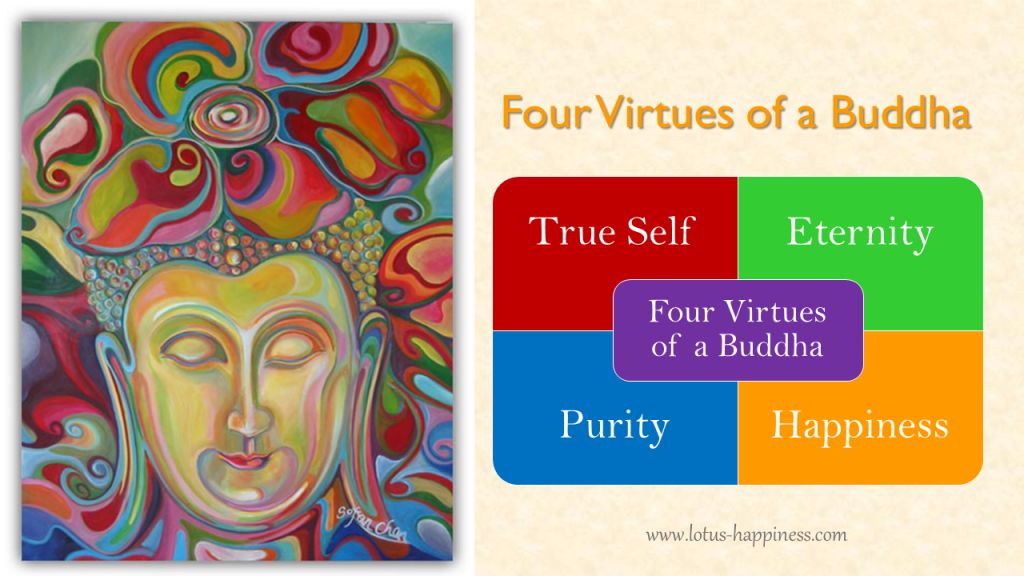
Next Sunday
The topic for Next Sunday is Six Paramitas. Stay tuned.
Let’s Connect
Here are ways to be updated of the latest posts:
Follow us by Liking our Facebook
Subscribe our Newsletter
Support Lotus Happiness
Do consider supporting Lotus Happiness in the Dharma propagation by purchasing
- a physical copy of the Lotus Sutra in the Amazon, or
- Instant Download of the Lotus Sutra (E-Book):

Share with your Friends
Enjoying the post? Leave a comment or share with your friends!
Schedule of Sunday Buddhism Class







